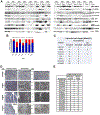Genes associated with bowel metastases in ovarian cancer
- PMID: 31204077
- PMCID: PMC8767766
- DOI: 10.1016/j.ygyno.2019.06.010
Genes associated with bowel metastases in ovarian cancer
Abstract
Objective: This study is designed to identify genes and pathways that could promote metastasis to the bowel in high-grade serous ovarian cancer (OC) and evaluate their associations with clinical outcomes.
Methods: We performed RNA sequencing of OC primary tumors (PTs) and their corresponding bowel metastases (n = 21 discovery set; n = 18 replication set). Differentially expressed genes (DEGs) were those expressed at least 2-fold higher in bowel metastases (BMets) than PTs in at least 30% of patients (P < .05) with no increased expression in paired benign bowel tissue and were validated with quantitative reverse transcription PCR. Using an independent OC cohort (n = 333), associations between DEGs in PTs and surgical and clinical outcomes were performed. Immunohistochemistry and mouse xenograft studies were performed to confirm the role of LRRC15 in promoting metastasis.
Results: Among 27 DEGs in the discovery set, 21 were confirmed in the replication set: SFRP2, Col11A1, LRRC15, ADAM12, ADAMTS12, MFAP5, LUM, PLPP4, FAP, POSTN, GRP, MMP11, MMP13, C1QTNF3, EPYC, DIO2, KCNA1, NETO1, NTM, MYH13, and PVALB. Higher expression of more than half of the genes in the PT was associated with an increased requirement for bowel resection at primary surgery and an inability to achieve complete cytoreduction. Increased expression of LRRC15 in BMets was confirmed by immunohistochemistry and knockdown of LRRC15 significantly inhibited tumor progression in mice.
Conclusions: We identified 21 genes that are overexpressed in bowel metastases among patients with OC. Our findings will help select potential molecular targets for the prevention and treatment of malignant bowel obstruction in OC.
Keywords: Bowel metastasis; Differentially expressed genes; Extracellular matrix; Malignant bowel obstruction; Ovarian cancer.
Published by Elsevier Inc.
Conflict of interest statement
Declaration of Competing Interest
S.J.W declares research funding from Novartis, Genetech, Tesaro, and KIVATEC and an Ovarian PDX patent with royalties. All other authors declare no conflicts of interest.
Figures




Similar articles
-
Comparative transcriptome analysis of matched primary and distant metastatic ovarian carcinoma.BMC Cancer. 2019 Nov 19;19(1):1121. doi: 10.1186/s12885-019-6339-0. BMC Cancer. 2019. PMID: 31744494 Free PMC article.
-
A collagen-remodeling gene signature regulated by TGF-β signaling is associated with metastasis and poor survival in serous ovarian cancer.Clin Cancer Res. 2014 Feb 1;20(3):711-23. doi: 10.1158/1078-0432.CCR-13-1256. Epub 2013 Nov 11. Clin Cancer Res. 2014. PMID: 24218511 Free PMC article.
-
Targeting LRRC15 Inhibits Metastatic Dissemination of Ovarian Cancer.Cancer Res. 2022 Mar 15;82(6):1038-1054. doi: 10.1158/0008-5472.CAN-21-0622. Cancer Res. 2022. PMID: 34654724 Free PMC article.
-
Experimental models for ovarian cancer research.Exp Cell Res. 2022 Jul 1;416(1):113150. doi: 10.1016/j.yexcr.2022.113150. Epub 2022 Apr 8. Exp Cell Res. 2022. PMID: 35405118 Review.
-
Harnessing preclinical models for the interrogation of ovarian cancer.J Exp Clin Cancer Res. 2022 Sep 16;41(1):277. doi: 10.1186/s13046-022-02486-z. J Exp Clin Cancer Res. 2022. PMID: 36114548 Free PMC article. Review.
Cited by
-
BAY-9835: Discovery of the First Orally Bioavailable ADAMTS7 Inhibitor.J Med Chem. 2024 Feb 22;67(4):2907-2940. doi: 10.1021/acs.jmedchem.3c02036. Epub 2024 Feb 13. J Med Chem. 2024. PMID: 38348661 Free PMC article.
-
CAPRIN1 Transcriptionally Activated PLPP4 to Inhibit DOX Sensitivity and Promote Breast Cancer Progression.Cell Biochem Biophys. 2025 Jun;83(2):2035-2045. doi: 10.1007/s12013-024-01614-0. Epub 2024 Nov 18. Cell Biochem Biophys. 2025. PMID: 39556159
-
Clonal tracking in cancer and metastasis.Cancer Metastasis Rev. 2024 Jun;43(2):639-656. doi: 10.1007/s10555-023-10149-4. Epub 2023 Nov 1. Cancer Metastasis Rev. 2024. PMID: 37910295 Free PMC article. Review.
-
Exploiting LRRC15 as a Novel Therapeutic Target in Cancer.Cancer Res. 2022 May 3;82(9):1675-1681. doi: 10.1158/0008-5472.CAN-21-3734. Cancer Res. 2022. PMID: 35260879 Free PMC article. Review.
-
Epiphycan Predicts Poor Outcomes and Promotes Metastasis in Ovarian Cancer.Front Oncol. 2021 Nov 23;11:653782. doi: 10.3389/fonc.2021.653782. eCollection 2021. Front Oncol. 2021. PMID: 34888227 Free PMC article.
References
Publication types
MeSH terms
Substances
Grants and funding
LinkOut - more resources
Full Text Sources
Medical
Miscellaneous

